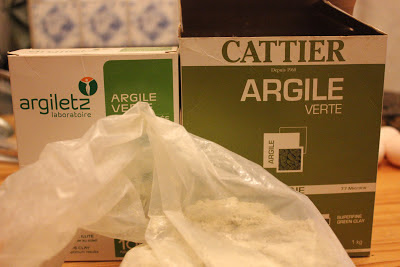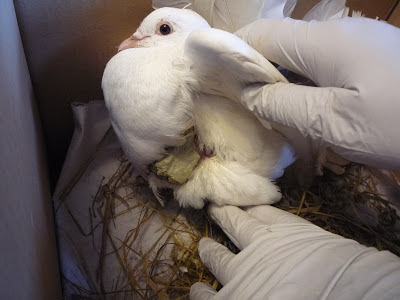Solutions then and now
The
first thing I did (and still do today), was to instigate 'time-out', I
firmly believe in this procedure for both the perpetrator and victim in
cases of bullying and stress and that they should be kept
apart for at least some hours of the day. Most importantly this should
include the key periods when stress levels can become elevated, so, if you have them, set feeding times and the hour before they go to
roost. When you finally decide to regroup them as a flock, you may have to make
yourself the dominant 'bird', so as to ensure that the victim gets well-fed. You can do this either by policing the food plates or more easily getting
her/him out first thing in the morning. At night you may have to
physically arrange everyone on the perch. Not only does this help the
'stressed-out' but also the 'stressor' as it puts you firmly above him
or her in the pecking order.
I would not under any circumstances put either bird in a cage within view of the other or any other member of the flock. In fact I would cut out the idea of cages altogether. A cage to a hen is what it would be to us and just furthers the idea of division and difference in status. If you do not have the room to move birds about then try to find a friend to take one of the birds for a day or so. If the worst comes to the worst, although if you have a homestead this probably means no big deal, bring your bird inside your house.
Giving a bird some tlc, at any difficult part of its life not only boosts its confidence but helps it when it returns into the flock. You have by allowing it into your domain, given it a little edge, a bond between you. Hastings (left) had a dreadful fight with his brother over a hen and the time we spent just calming him down and giving him a big hug probably did just as much for his stress levels as the electrolyte and wound treatment achieved.
I would not under any circumstances put either bird in a cage within view of the other or any other member of the flock. In fact I would cut out the idea of cages altogether. A cage to a hen is what it would be to us and just furthers the idea of division and difference in status. If you do not have the room to move birds about then try to find a friend to take one of the birds for a day or so. If the worst comes to the worst, although if you have a homestead this probably means no big deal, bring your bird inside your house.
Giving a bird some tlc, at any difficult part of its life not only boosts its confidence but helps it when it returns into the flock. You have by allowing it into your domain, given it a little edge, a bond between you. Hastings (left) had a dreadful fight with his brother over a hen and the time we spent just calming him down and giving him a big hug probably did just as much for his stress levels as the electrolyte and wound treatment achieved.
 I
made sure of it then and it is a rule I have followed ever since, that
at night everyone can perch at the same height. I always construct my perches
to be at one level and ensure everyone is positioned on them. I now
instinctively know who will not get on with whom and which hen or
cockerel can act as an intermediary. Again, I think of my chickens as
individuals, hens have off days, particularly if broody, relationships
with others are fluid and thus can change. Any chicken who is broody or
maybe through age or injury can not/or just won't perch is given a
cardboard box. This box has seemingly some significance in hen house
shibboleths, it seems to stand for a separate entity within the house.
Whereas, sitting on the floor or perching on a lower level than the rest
signifies lower station.
I
made sure of it then and it is a rule I have followed ever since, that
at night everyone can perch at the same height. I always construct my perches
to be at one level and ensure everyone is positioned on them. I now
instinctively know who will not get on with whom and which hen or
cockerel can act as an intermediary. Again, I think of my chickens as
individuals, hens have off days, particularly if broody, relationships
with others are fluid and thus can change. Any chicken who is broody or
maybe through age or injury can not/or just won't perch is given a
cardboard box. This box has seemingly some significance in hen house
shibboleths, it seems to stand for a separate entity within the house.
Whereas, sitting on the floor or perching on a lower level than the rest
signifies lower station.Birds are very much a cohesive group at night, they preen and chatter and presumably 'chill out ' from the tensions of the day. The cockerels flap and crow together in the morning so any indication that one bird has more height advantage i.e. status, than the dominant hen and cockerel, can begin to cause problems and therefore result in stress. Sneezy the Silver Sebright hen, perched left, is in fact dominant!
Physical Fights, Flock and Family Feuds, Stress, Problems and Solutions

The
worst fights with resultant elevated stress levels I have witnessed in
my flock have been duels between brothers over a single hen. The rest of
the altercations between cockerels have been purely ritualistic and
with no actual physical contact. In 14 years these brotherly feuds have
happened 3 times and have always ended in blood and tears or rather tears to
the wattles. Although we have normally been able to sort these out by
implementing the above strategies, I was once obliged, in the case of
three brothers, to finally give one away and interestingly he became the dominant cockerel in that new flock. Mostly however, time out, tlc and
staggered feeding and supervised perching times works. In addition
letting one of the duellists out early in the morning amongst the hens
also allows him to meet other partners and often solves the problem.
Similarly,
I have hens who fight over nest boxes. In the old hen house, we had a
three compartment nest box, which Dorothy and the Ardenners squabbled
over now and again but not with any real elevated stress levels.
However, these two Polish x Ardenner sisters got into such a fit of
pique with each other over the middle box, that I took the partitions
out. Sometimes the simplest solutions are the best!
Food,
in particular insect and invertebrate protein and the competition for
it can sometimes cause conflict and stress. So siting a compost bin within each
territory and regularly having digging sessions within the same, really
helps sort this out. The requirement for the amino acid methionine has a
direct effect on the nervous system and something we need to provide
for. Hen fights over food can be nasty affairs, with hens pulling
feathers and pecking at each other. Making adequate provision for a
whole raft of foodstuffs but in particular wild protein and greenery
seems to me to be of tantamount importance. This is never more pressing
than when a hen has chickens, lack of protein for the babies just adds
to the stress. Luckily and for reasons only they could tell you, my four
flocks allow passe-partout in all territories for mothers with chicks
and even later in their development, there is some leeway allowed when these same chicks leave the
nest.
Territorial boundaries, the siting and design of hen houses and how they affect the nervous systems of the flock, predator stress and forest gardening solutions will all be dealt with in the next post.
Territorial boundaries, the siting and design of hen houses and how they affect the nervous systems of the flock, predator stress and forest gardening solutions will all be dealt with in the next post.
If you enjoyed this article and found it found it useful, feel free to share, comment and ask questions. All the best and thanks for dropping by,
Sue




























































